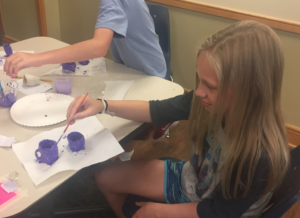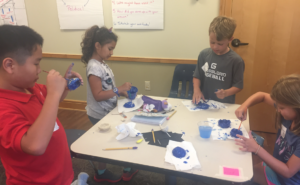Summer SAVY 2018: Session 6, Day 1 – Archaeology and Ancient Culture (Rising 3rd/4th)
Dear SAVY parents,
Our budding archaeologists had a wonderful first day in Mesoamerica! Students arrived ready to learn, and everyone showed their excitement right off the bat! We began this morning by playing People Bingo to get to know one another! Sort of like a scavenger hunt, students had a lot of fun asking each other questions like, “Have you ever been to an archaeological site,” “Have you ever met anyone famous,” and “Do you have more than 10 first cousins?” After this, we took a few minutes to complete our concept maps, which are used to find out what students already know about archaeology. Next, we talked about what it is we think archaeologists do versus what archaeologists actually do! Like most adults, many of the students were surprised to learn that archaeologists do NOT study dinosaurs! Instead, archaeologists study the history of humankind through the materials left behind by ancient people. Once we had that squared away, we discussed the location of Mesoamerica and the civilizations that lived there before Europeans arrived in the Americas. We looked at photos of archaeological sites from the Olmec, Zapotec, Maya, Mixtec, and Aztec civilizations, covering approximately 3,500 years of history! Keeping in line with our Big Picture concept this week, we began discussing systems, and I was pleasantly surprised to find that many of the students already knew what a system is and how it works! Throughout the rest of the week, we will be exploring how social, economic, and politic systems worked together in Mesoamerica to sustain these civilizations for centuries! Today, we started with social systems, which make up the base of the other systems. Since most social systems start at the household level, students were organized into four groups (or “households”), and each household was responsible for producing a particular type of clay craft (bowls, plates, cups, vases). After we shaped our crafts, students painted their pottery with specific colors that reflect the connections between members of each household. Later in the week, students will have the chance to see how these materials move through the economic and political systems and eventually end up in the archaeological record where they are interpreted by archaeologists! I think it’s going to be a really exciting week!
Here are a few discussion questions you can talk about with your students:
1. What is a system?
2. What types of elements make up a social system?
3. What is the difference between an artifact and a feature? What are some examples of each?
4. Why is it important for archaeologists to know how old artifacts or features are?
Thanks very much!
Phyllis Johnson
Painting Our “Ancient Artifacts”



